Welcome to readers of the Afraid to Trade blog. Good to have you here, although I wish it was for a "we can only go higher at this point" analysis.
As for the Big Picture, what can I say? I think that was one of the first econ blogs I found and have been hooked since my first reading.
Saturday, November 24, 2007
Is a Bear Market Forming?, pt. II
At the end of every week, I go to the stockcharts.com performance function to see how the major ETFs (using the XL__ series) have performed over various time frames. I look at returns for the following time periods: year, 180 days, 90 days, 30 days, 10 days and week. What I'm looking for are general trends to see how money is shifting in the market. I then look at the charts to see what they are saying.
Here are some observations from that analysis.
1.) The XLEs and XLBs -- which were a prime driver of the latest bull market -- have stopped advancing. This may be a sign that traders who rode these sectors for most of the year are getting out and taking profits.
2.) The financials -- which comprise about 20% of the S&P 500 -- have a negative return for all the time periods.
3.) Consumer discretionary has a negative return for all but one time frame (yearly).
4.) Over the last 30, 10 and weekly period, the best performing sectors are utilities (which performed best over the last 30 days) and consumer staples (which performed best over the last 10 days). Energy popped over the last 5 day period, largely thanks to oil's rally.
In short, it looks as though traders are taking profits in the previously strong areas of the market and are shifting those realized gains into safer, recession resistant areas of the market.
In addition, consider the following charts:
Consumer Discretionary
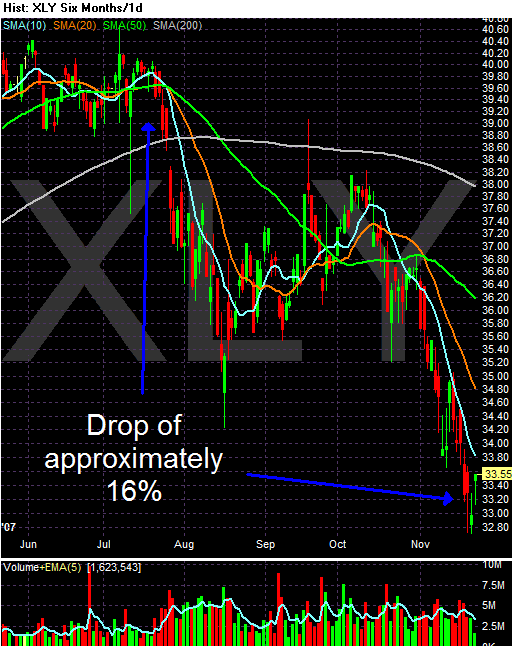
Financials
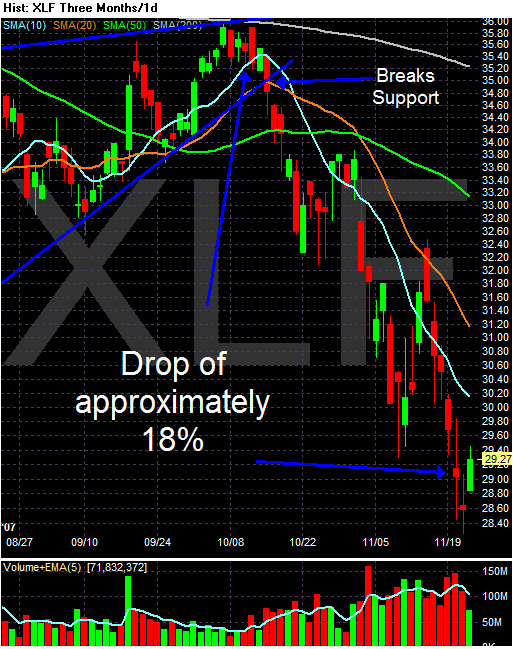
Transportation

The dollar
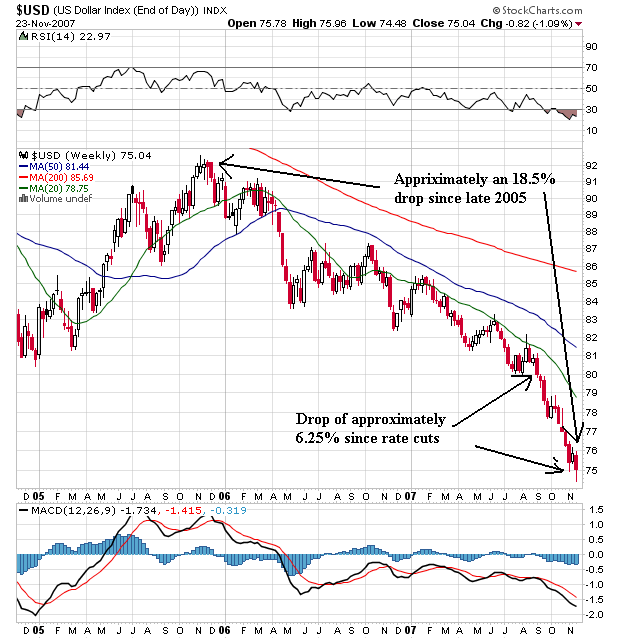
These are not good looking charts -- unless you are looking to short the market.
Here are some observations from that analysis.
1.) The XLEs and XLBs -- which were a prime driver of the latest bull market -- have stopped advancing. This may be a sign that traders who rode these sectors for most of the year are getting out and taking profits.
2.) The financials -- which comprise about 20% of the S&P 500 -- have a negative return for all the time periods.
3.) Consumer discretionary has a negative return for all but one time frame (yearly).
4.) Over the last 30, 10 and weekly period, the best performing sectors are utilities (which performed best over the last 30 days) and consumer staples (which performed best over the last 10 days). Energy popped over the last 5 day period, largely thanks to oil's rally.
In short, it looks as though traders are taking profits in the previously strong areas of the market and are shifting those realized gains into safer, recession resistant areas of the market.
In addition, consider the following charts:
Consumer Discretionary

Financials

Transportation

The dollar

These are not good looking charts -- unless you are looking to short the market.
Friday, November 23, 2007
Thursday, November 22, 2007
Is a Bear Market Developing?
First -- this will be a long post. In addition, I'm going to leave this up for awhile because I want to rethink the logic behind this post for a bit to see if I agree or disagree with it after awhile.
Here is the territory I'm going to cover.
1.) A long-term view of the markets (4-5 years). There are bullish and bearish implications to consider.
2.) An intermediate view of the marker (1 year).
3.) A look at the Russell 2000 and Transportation averages.
4.) A look at market breadth.
5.) A flight to safety in the form of a bond market rally.
A long-term view of the markets (4-5 years).
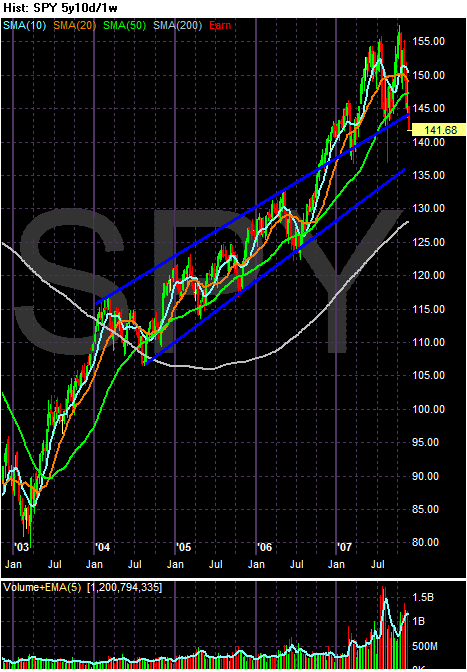
This is a 5-year chart of the SPYs broken down into weekly movements. Notice the upward sloping channel that started in early 2004. The SPYs broke out of this channel in late 2006 and have since used the upper band of the channel as support. Currently, the index has broken through this support and is heading for the lower trend channel.
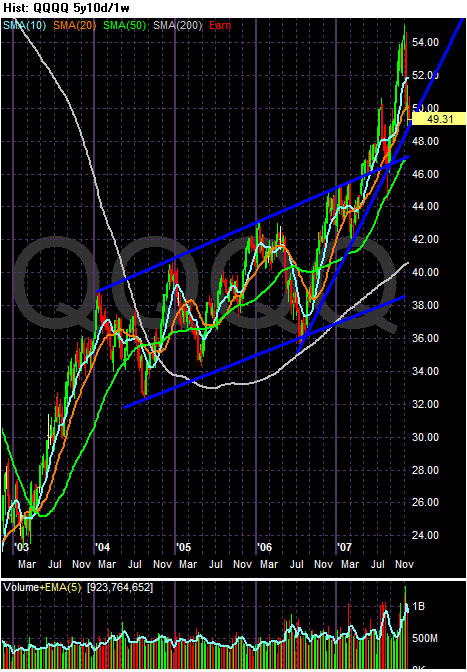
This is a 5-year chart of the QQQQs broken down into weekly movements. Notice there are two trends in place. The first is an upward sloping trading channel that started at the beginning of 2004. The second is an upward sloping rally that started in mid-2006. Currently, the QQQQs are approaching the trend line that started in mid-2006.
Let's stop here and make an important observation: The SPYs and QQQQs still have strong support for their uptrend. The QQQQs have three supporting trend lines -- the one that started in mid-2006 and the upper and lower bands of the upward sloping channel that started in 2004. The SPYs still have the lower trend line of the upward sloping channel that started in early 2004. In other words, these indexes still are in decent technical shape.
However, notice that on both the QQQQs and SPY charts above the last part of each rally is characterized by heavy volume. This may be a selling climax:
Also consider this passage from Gartley's Profits in the Stock Market (page 219:
The heavy volume could be a buying climax.
An intermediate view of the marker (1 year)
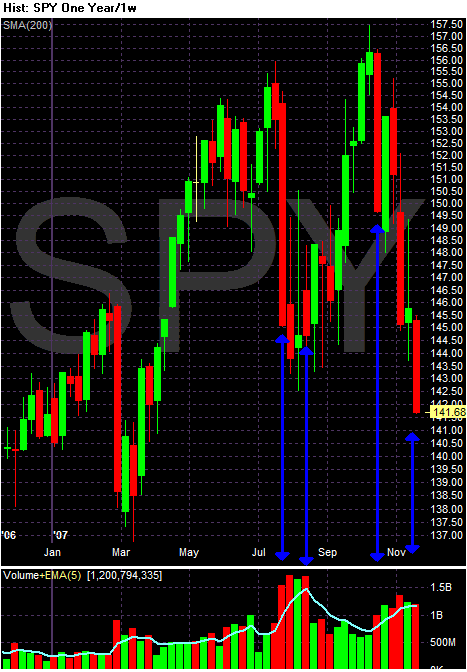
This is a one year chart of the SPYs in weekly candles. Notice the two areas marked by arrows. These are heavy selling areas where the market sold off hard on heavy volume. Notice the selling volume is noticeably higher than the preceding buying volume. This indicates traders have had a hair trigger for some time -- when it looks like it's time to take a profit, a ton of traders take a profit. This indicates traders don't have a lot of confidence in the strength of the rally.
Also note the SPYs may have formed a double top -- a reversal formation.
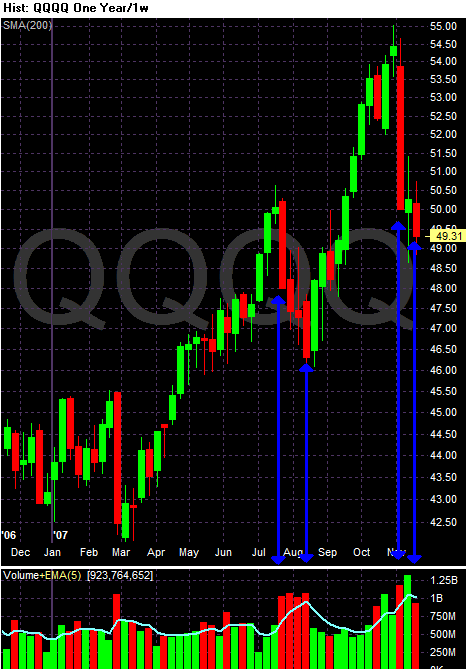
This is a one year chart of the QQQQs in weekly candles. Notice the two areas market by arrows. These are heavy selling areas where the market sold off hard on heavy volume. Notice the selling volume is noticeably higher than the preceding buying volume. This indicates traders have had a hair trigger for some time -- when it looks like it's time to take a profit, a ton of traders take a profit. This indicates traders don't have a lot of confidence in the strength of the rally.
So, to sum up so far:
1.) The long term trends for the SPY and QQQQ are still intact. But,
2.) We may have seen a selling climax over the last year, and
3.) We've seen traders develop a hair trigger in regards to the market; traders are selling quickly and in higher volume than the rallies.
A look at the Russell 2000 and Transportation averages.
Now, let's look at the markets that are causing concern.

This is a four year chart of the IWMs or Russell 2000. This index has already broken a 4-year uptrend. Let's make an assumption that the Russell 2000 is a proxy for risk appetite. If that is a correct assumption, then this trend break indicates the market's risk appetite is decreasing.
Let's add a complicating factor to this analysis. According to Investorpedia, a bear market is:
Eyeballing the IWMs, notice the high of about 86 and a current level of 73.00. That's a decrease of 14.53%, or pretty close to the definition of a bear market.
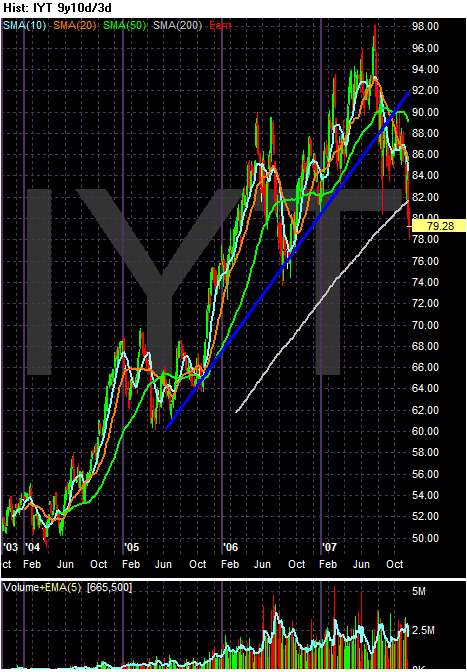
This is a weekly chart of the Transportation index in weekly bars. Notice this index has broken a 2 year uptrend. Remember this chart for the next chart.
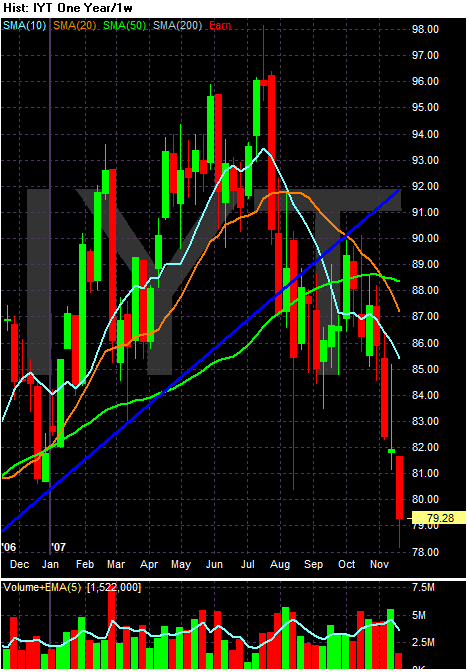
This is a one year chart of the transportation index in weekly bars. The high is about 96 and the current price is 79.28. That's a drop of 17.41%, clearly within the bear market definition.
OK, let's sum up what we've covered so far. The QQQQs and SPYs are still in a ling-term uptrend. The QQQQs have three levels of technical support and the SPYs have one level of technical support. In other words, these indexes are in decent shape. But, the Russell 2000 has broken a four year uptrend and has dropped a little under 15% since its high. And the Transportations index -- which Dow Theory says must confirm a an upward movement in stock prices -- has broken a two year uptrend and has fallen 17.41% since its high. That means there are two markets -- the Russell 2000 and the Transportation index -- which are either very close to bear market territory or in bear market territory.
A look at market breadth.
Market breadth has been declining for the last month.
NYSE advance/decline:
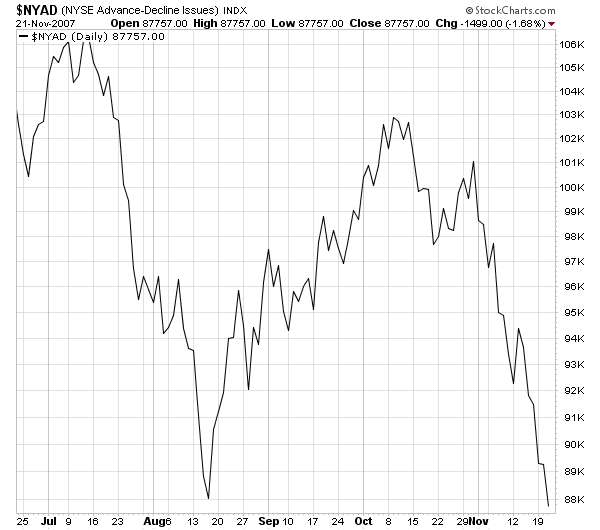
NYSE new highs/new lows

NASDAQ advance/decline

NASDAQ new highs/new lows
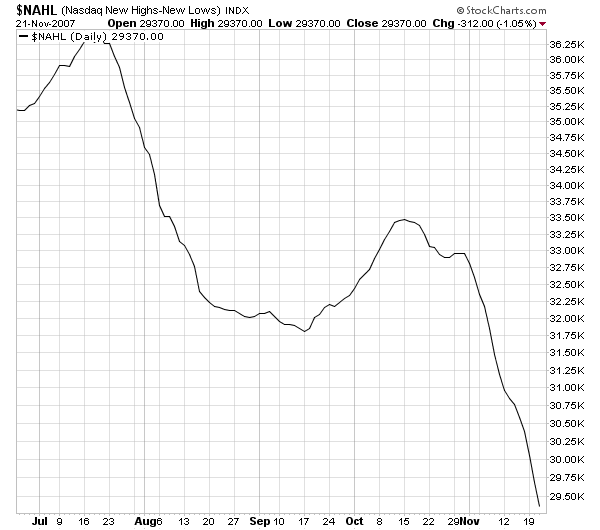
Regarding the NASDAQ, remember this market was the darling of the street over the last few months. Technology -- which had no exposure to real estate or the mortgage market -- was going to save the market. From mid August to the end of October the QQQQs increased about 18%. However, during this time note that NASDAQ market breadth was neutral for most of this rally, indicating that a few amount of issues were responsible for the rally.
A flight to safety in the form of a bond market rally.
Since the first sell-off in mid-July, the bond market has rallied. Treasury bonds are considered the safest investments around. One of the reasons investors move into Treasuries is they are concerned about the markets and are looking to park their money is safe investments to wait out the turmoil. Now -- it's also important to point out that another reason for the bond market rally could be the Fed cutting interest rates. A cut in interest rates makes debt issued before the rate cut more valuable. But while we have had rate cuts, we've also had a lot of bad economic news come out -- massive writedowns, declining consumer confidence and high gas prices (just to name a few). This is the type of news that concerns investors and pushes them into the safety of the Treasury market.
Here are the charts for the 1-3 year Treasury ETF, the 7-10 year Treasury ETf and the 20+ year Treasury ETF. Notice they have all rallied since July.
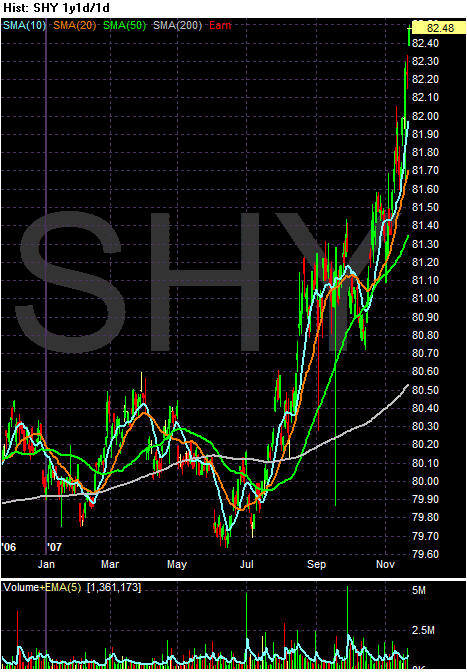
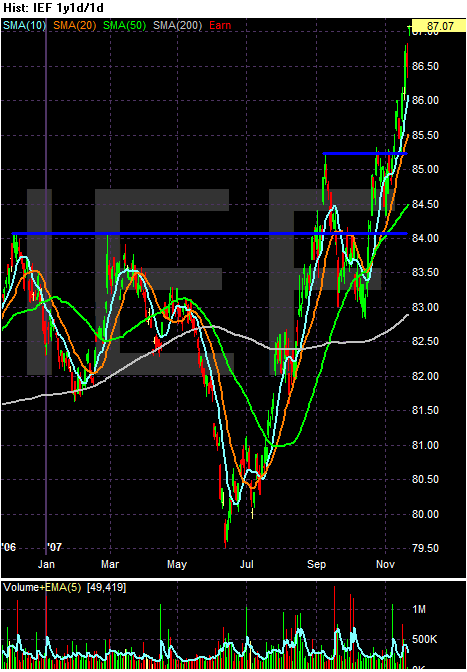
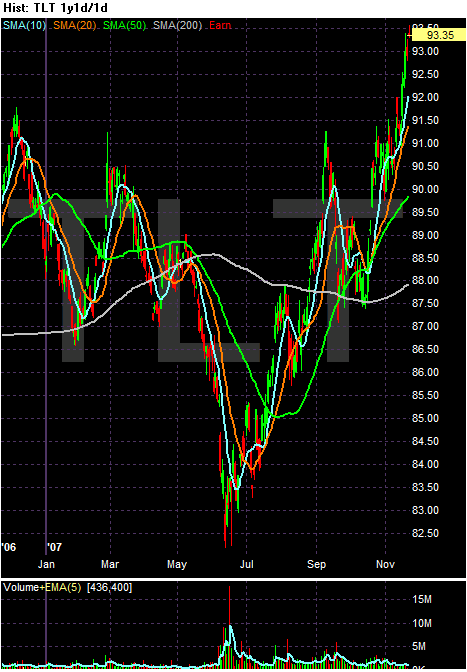
So -- let's sum everything up.
1.) The multi-year charts indicate the rally is still on, although the high volume over the last year may indicate we have seen a selling climax.
2.) The year chart shows traders have a hair trigger, and will sell on high volume.
3.) The Russell 2000 has broken a 4 year uptrend and is nearing a bear market sell-off point.
4.) The Transports are in bear market territory, preventing a Dow theory confirmation.
5.) Market breadth has been declining, especially on the NASDAQ during its latest rally.
6.) Investors are moving into Treasury debt, indicating a flight to safety may be going on.
This market has some serious chinks in its armor. The Russell 2000 and Transportation average are cause for serious concern. So is the lack of market breadth during the NASDAQ's latest rally and the Treasury market rally. If only one of the preceding facts was occurring we could dismiss it. However, with all four occurring at the same time, it's important to take a close look at the market to see if a rally can continue.
Here is the territory I'm going to cover.
1.) A long-term view of the markets (4-5 years). There are bullish and bearish implications to consider.
2.) An intermediate view of the marker (1 year).
3.) A look at the Russell 2000 and Transportation averages.
4.) A look at market breadth.
5.) A flight to safety in the form of a bond market rally.
A long-term view of the markets (4-5 years).

This is a 5-year chart of the SPYs broken down into weekly movements. Notice the upward sloping channel that started in early 2004. The SPYs broke out of this channel in late 2006 and have since used the upper band of the channel as support. Currently, the index has broken through this support and is heading for the lower trend channel.

This is a 5-year chart of the QQQQs broken down into weekly movements. Notice there are two trends in place. The first is an upward sloping trading channel that started at the beginning of 2004. The second is an upward sloping rally that started in mid-2006. Currently, the QQQQs are approaching the trend line that started in mid-2006.
Let's stop here and make an important observation: The SPYs and QQQQs still have strong support for their uptrend. The QQQQs have three supporting trend lines -- the one that started in mid-2006 and the upper and lower bands of the upward sloping channel that started in 2004. The SPYs still have the lower trend line of the upward sloping channel that started in early 2004. In other words, these indexes still are in decent technical shape.
However, notice that on both the QQQQs and SPY charts above the last part of each rally is characterized by heavy volume. This may be a selling climax:
....For a buying climax, the opposite occurs, and the market begins to sell, resulting in lower prices. The climax is merely the highest point of selling or buying and can be followed by many trend reversals.
Also consider this passage from Gartley's Profits in the Stock Market (page 219:
There appears to be no exact counterpart of the selling climax, on the mull side of the market. At least, the past 40 teals' history does not seem to show any tops, either mayort or intermediate, which compare closely to the selling climaxes in either bull or bear markets. This is true, at least, of the price trend. If we want to consider activity, it is, of course, a fact that many bull market tops are accompanied by what might be called buying climax volume.
The heavy volume could be a buying climax.
An intermediate view of the marker (1 year)

This is a one year chart of the SPYs in weekly candles. Notice the two areas marked by arrows. These are heavy selling areas where the market sold off hard on heavy volume. Notice the selling volume is noticeably higher than the preceding buying volume. This indicates traders have had a hair trigger for some time -- when it looks like it's time to take a profit, a ton of traders take a profit. This indicates traders don't have a lot of confidence in the strength of the rally.
Also note the SPYs may have formed a double top -- a reversal formation.

This is a one year chart of the QQQQs in weekly candles. Notice the two areas market by arrows. These are heavy selling areas where the market sold off hard on heavy volume. Notice the selling volume is noticeably higher than the preceding buying volume. This indicates traders have had a hair trigger for some time -- when it looks like it's time to take a profit, a ton of traders take a profit. This indicates traders don't have a lot of confidence in the strength of the rally.
So, to sum up so far:
1.) The long term trends for the SPY and QQQQ are still intact. But,
2.) We may have seen a selling climax over the last year, and
3.) We've seen traders develop a hair trigger in regards to the market; traders are selling quickly and in higher volume than the rallies.
A look at the Russell 2000 and Transportation averages.
Now, let's look at the markets that are causing concern.

This is a four year chart of the IWMs or Russell 2000. This index has already broken a 4-year uptrend. Let's make an assumption that the Russell 2000 is a proxy for risk appetite. If that is a correct assumption, then this trend break indicates the market's risk appetite is decreasing.
Let's add a complicating factor to this analysis. According to Investorpedia, a bear market is:
A market condition in which the prices of securities are falling or are expected to fall. Although figures can vary, a downturn of 15-20% or more in multiple indexes (Dow or S&P 500) is considered an entry into a bear market.
Eyeballing the IWMs, notice the high of about 86 and a current level of 73.00. That's a decrease of 14.53%, or pretty close to the definition of a bear market.

This is a weekly chart of the Transportation index in weekly bars. Notice this index has broken a 2 year uptrend. Remember this chart for the next chart.

This is a one year chart of the transportation index in weekly bars. The high is about 96 and the current price is 79.28. That's a drop of 17.41%, clearly within the bear market definition.
OK, let's sum up what we've covered so far. The QQQQs and SPYs are still in a ling-term uptrend. The QQQQs have three levels of technical support and the SPYs have one level of technical support. In other words, these indexes are in decent shape. But, the Russell 2000 has broken a four year uptrend and has dropped a little under 15% since its high. And the Transportations index -- which Dow Theory says must confirm a an upward movement in stock prices -- has broken a two year uptrend and has fallen 17.41% since its high. That means there are two markets -- the Russell 2000 and the Transportation index -- which are either very close to bear market territory or in bear market territory.
A look at market breadth.
Market breadth has been declining for the last month.
NYSE advance/decline:

NYSE new highs/new lows

NASDAQ advance/decline

NASDAQ new highs/new lows

Regarding the NASDAQ, remember this market was the darling of the street over the last few months. Technology -- which had no exposure to real estate or the mortgage market -- was going to save the market. From mid August to the end of October the QQQQs increased about 18%. However, during this time note that NASDAQ market breadth was neutral for most of this rally, indicating that a few amount of issues were responsible for the rally.
A flight to safety in the form of a bond market rally.
Since the first sell-off in mid-July, the bond market has rallied. Treasury bonds are considered the safest investments around. One of the reasons investors move into Treasuries is they are concerned about the markets and are looking to park their money is safe investments to wait out the turmoil. Now -- it's also important to point out that another reason for the bond market rally could be the Fed cutting interest rates. A cut in interest rates makes debt issued before the rate cut more valuable. But while we have had rate cuts, we've also had a lot of bad economic news come out -- massive writedowns, declining consumer confidence and high gas prices (just to name a few). This is the type of news that concerns investors and pushes them into the safety of the Treasury market.
Here are the charts for the 1-3 year Treasury ETF, the 7-10 year Treasury ETf and the 20+ year Treasury ETF. Notice they have all rallied since July.



So -- let's sum everything up.
1.) The multi-year charts indicate the rally is still on, although the high volume over the last year may indicate we have seen a selling climax.
2.) The year chart shows traders have a hair trigger, and will sell on high volume.
3.) The Russell 2000 has broken a 4 year uptrend and is nearing a bear market sell-off point.
4.) The Transports are in bear market territory, preventing a Dow theory confirmation.
5.) Market breadth has been declining, especially on the NASDAQ during its latest rally.
6.) Investors are moving into Treasury debt, indicating a flight to safety may be going on.
This market has some serious chinks in its armor. The Russell 2000 and Transportation average are cause for serious concern. So is the lack of market breadth during the NASDAQ's latest rally and the Treasury market rally. If only one of the preceding facts was occurring we could dismiss it. However, with all four occurring at the same time, it's important to take a close look at the market to see if a rally can continue.
Today's Markets
Actually, it's yesterday's markets because all of this happened, well, yesterday. Also, this is going to be a short post. I'm working on a longer post next which will give some more overall detail about what is going on in the markets.
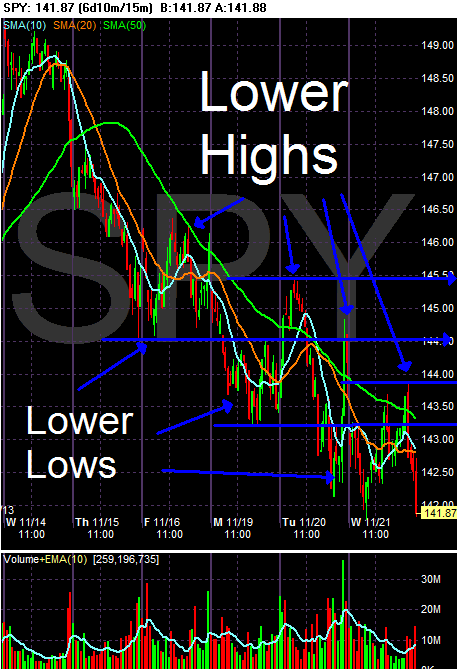
The SPYs are in a short-term downtrend. The index is making lower highs and lower lows. Also note that traders are engaging in heavy end of day selling before the long weekend, indicating there is concern and/or nervousness before the holiday.
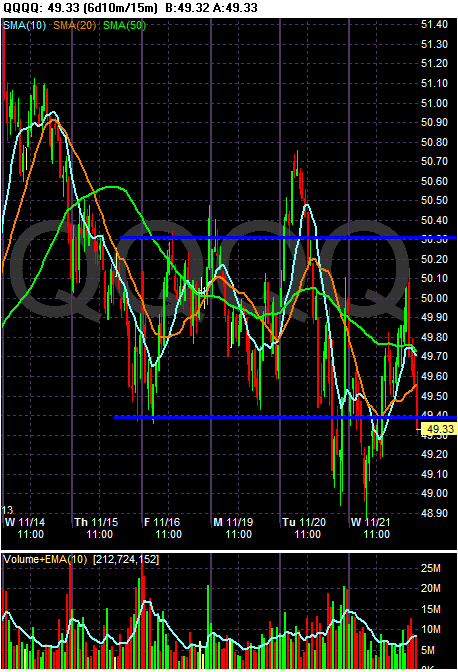
The QQQQs are still in a general trading range, looking for somewhere to go.
Again -- I've got a much longer post that I'll put up on Friday morning. Until then, have a good Thanksgiving.

The SPYs are in a short-term downtrend. The index is making lower highs and lower lows. Also note that traders are engaging in heavy end of day selling before the long weekend, indicating there is concern and/or nervousness before the holiday.

The QQQQs are still in a general trading range, looking for somewhere to go.
Again -- I've got a much longer post that I'll put up on Friday morning. Until then, have a good Thanksgiving.
Wednesday, November 21, 2007
Weekend Weimar and Beagle
Tomorrow is Thanksgiving. I'll put up a market update tomorrow afternoon. Until then, don't even think about the market. Think about turkey and all the good food and company you'll be enjoying tomorrow.
In honor of the future Mr$. Bonddad, I am also including a picture of a Beagle.


In honor of the future Mr$. Bonddad, I am also including a picture of a Beagle.


Treasury Markets Rallying
From Bloomberg:
The truth is Treasuries have been rallying since the first market sell-off in July.
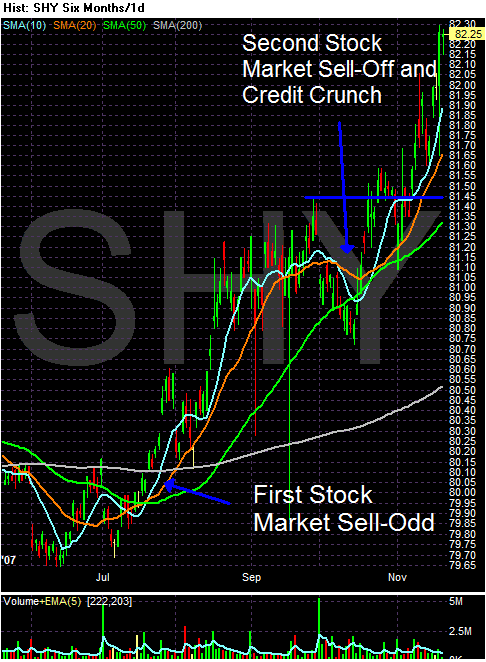
The ETF for short-term treasuries (1-3 years) shows a strong rally in place as investors look for a safe place to park money.
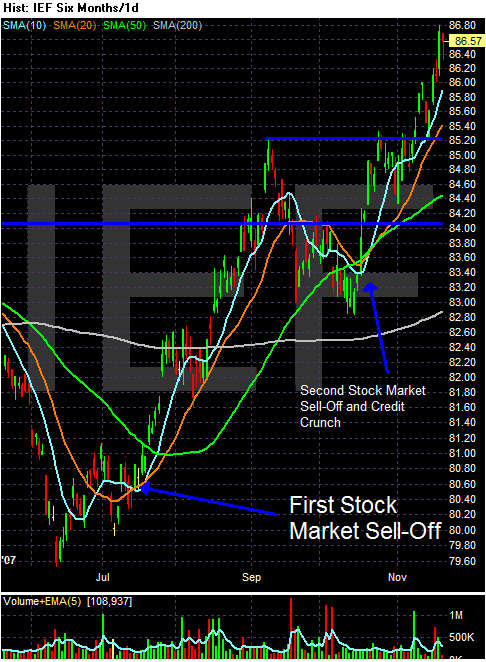
The 7-10 year Treasury ETF also shows a strong rally for the same reasons.
It's important to remember there are several overarching themes that drive fixed income investing.
1.) Overall interest rate policy. As the fed cuts rates, bonds that were issued before the cut become more valuable because they have a higher coupon. As the Fed increases interest rates, bonds issued before the rate increase are less valuable because they have a lower coupon.
2.) Inflation expectations: Because bonds pay a fixed amount of interest, an increase in inflation decreases overall return for fixed income investing.
3.) Risk perception: Treasuries are considered ultra-safe investments. Therefore, when investors are concerned about risk they tend to flock to Treasuries for their overall safety.
These reasons vary in importance. For example, my guess is that right now the overall financial risk in the system is one of the primary reasons people are moving into bonds. Traders/investors are concerned about the stock market's volatility and overall direction. Investors are also concerned about the underlying strength of the economy. Therefore, they are moving into bonds.
U.S. Treasuries surged, sending 10- year yields below 4 percent for the first time in more than two years, as a decline in global stocks spurred demand for the safety of government debt.
Notes climbed as U.S. stock futures dropped to near three- month lows and oil approached $100 a barrel. The spread, or difference in yield, between two- and 10-year Treasuries widened to the most since January 2005 as investors favored safer, shorter-dated assets.
``The oil price hurt equities, and now we're back on the risk trade supporting'' U.S. notes, said David Keeble, head of fixed-income strategy at Calyon, the investment-banking arm of Credit Agricole SA, France's second-biggest bank. ``Everybody's rushing to the front end.''
The truth is Treasuries have been rallying since the first market sell-off in July.

The ETF for short-term treasuries (1-3 years) shows a strong rally in place as investors look for a safe place to park money.

The 7-10 year Treasury ETF also shows a strong rally for the same reasons.
It's important to remember there are several overarching themes that drive fixed income investing.
1.) Overall interest rate policy. As the fed cuts rates, bonds that were issued before the cut become more valuable because they have a higher coupon. As the Fed increases interest rates, bonds issued before the rate increase are less valuable because they have a lower coupon.
2.) Inflation expectations: Because bonds pay a fixed amount of interest, an increase in inflation decreases overall return for fixed income investing.
3.) Risk perception: Treasuries are considered ultra-safe investments. Therefore, when investors are concerned about risk they tend to flock to Treasuries for their overall safety.
These reasons vary in importance. For example, my guess is that right now the overall financial risk in the system is one of the primary reasons people are moving into bonds. Traders/investors are concerned about the stock market's volatility and overall direction. Investors are also concerned about the underlying strength of the economy. Therefore, they are moving into bonds.
Oil Hits Record; Dollar Drops; US' "Strong Dollar" Policy Sucks
From the WSJ:
Let's tie a couple a large themes together.
1.) One of the reasons I argued against the Fed's rate cut was a cut would hammer the dollar. As this chart below shows, the dollar has dropped about 4.4% (approximately) since the Fed cut interest rates.
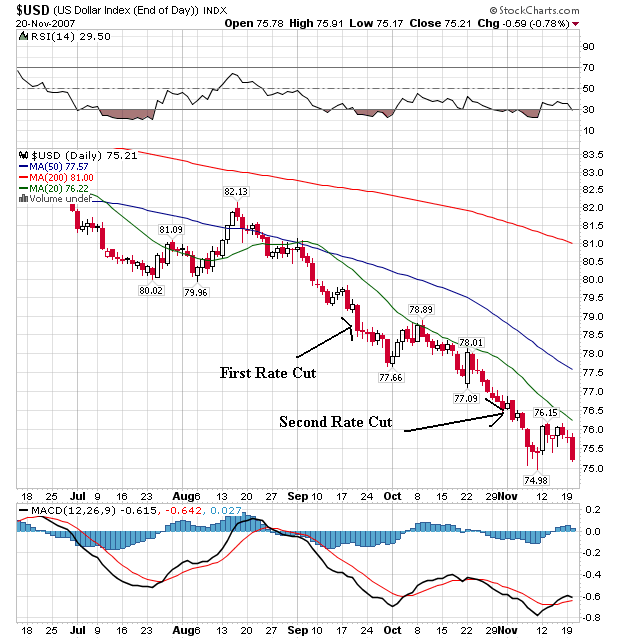
The Fed's cuts merely accelerated a downward trend in the dollar that has been in place for the last two years. Note on the following weekly chart that the dollar's descent was orderly until the Fed started cutting rates. Since then the dollar's downward move has been much faster.
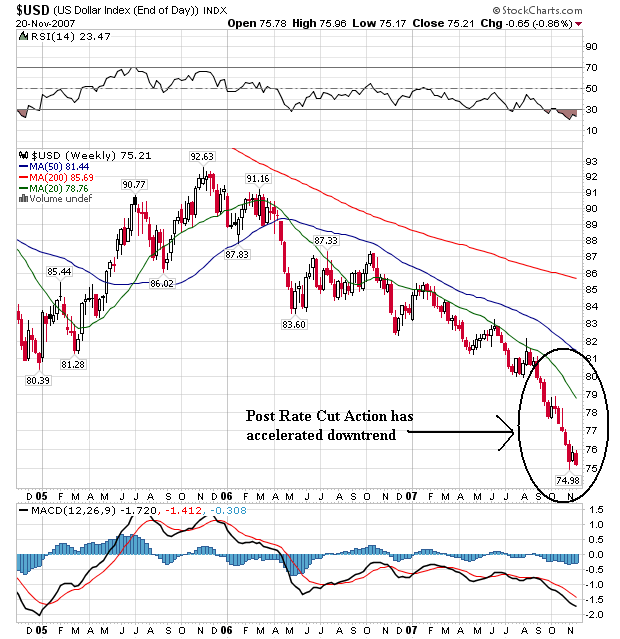
Now let's turn to oil's chart.
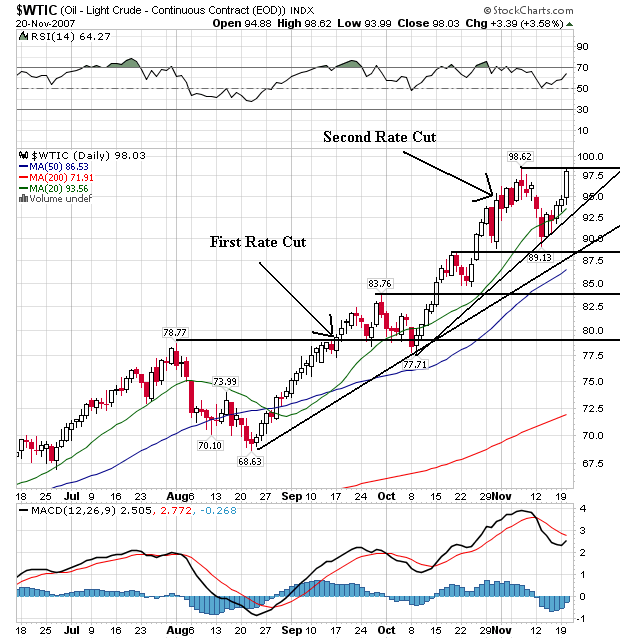
Notice the following.
1.) This is a bull market chart. Prices are making higher highs and higher lows. In addition, prices are moving beyond previously established highs. All of the simple moving averages (SMAs) are moving higher. Prices are above the SMAs. This chart says "find a buy point, NOW."
2.) Notice that oil has risen about 25% since the Fed started cutting rates. As the dollar has decreased oil has increased as a hedge against the dollar's devaluation. In addition, the dollar's drop has in and of itself devalued oil because oil is priced in dollars.
So, as the dollar has dropped traders have purchased oil as an inflation hedge. As a result, gasoline prices at the pump at a lot higher now than they were at the same time last year -- and they're increasing:
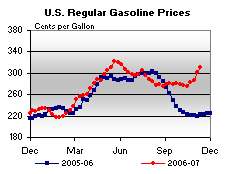
I couldn't end this post without harping on the continual statements from the US that "we have a strong dollar policy." Please stop it. You're doing nothing but making asses out of yourselves with these statements. If this is what a strong dollar policy looks like, I'd hate to see what a weak dollar policy looks like.
Crude-oil prices leapt 3.6% to a new commodities-market high of more than $98 a barrel, adding to growing evidence that the cost could remain high for months and pose a challenge to the economies of many industrialized nations.
A survey of energy analysts by Dow Jones Newswires released yesterday found these observers believed oil prices would stay strong well into next year. They forecast that prices would simmer down only at the end of 2008, as the world's richest economies, including the U.S., begin to flag.
The weakening U.S. dollar, the currency used to buy and sell oil globally, is helping reinforce the notion that oil prices could remain high. The dollar fell against the euro yesterday after the Federal Open Market Committee released minutes from its most recent meeting. A weaker dollar blunts the effect of higher oil prices outside the U.S. and gives purchasers in other currencies greater power.
.....
Looking ahead, energy analysts see little to reverse current trends that have sent oil on its record trajectory this year. "Demand growth has been surprisingly strong, especially in the emerging markets, supply hasn't really responded, and the weaker [U.S.] dollar has driven up prices because of strong demand in the U.K. and Europe," said Royal Bank of Scotland Group PLC senior economic adviser Thorsten Fischer.
.....
But oil markets are still bedeviled by longer-term trends: growing demand from the developing world, continued supply constraints and political uncertainties in major oil-producing regions like the Middle East. "Despite apparent weakness in the U.S. economy, the global economy is going ahead. China and India continue to march forward and demand oil and OPEC isn't supplying much more," says Chris Ross, a vice president at consulting firm CRA International Inc. While oil prices can turn quickly, he said, "my belief is the balance of probabilities is towards strength rather than weakness."
Let's tie a couple a large themes together.
1.) One of the reasons I argued against the Fed's rate cut was a cut would hammer the dollar. As this chart below shows, the dollar has dropped about 4.4% (approximately) since the Fed cut interest rates.

The Fed's cuts merely accelerated a downward trend in the dollar that has been in place for the last two years. Note on the following weekly chart that the dollar's descent was orderly until the Fed started cutting rates. Since then the dollar's downward move has been much faster.

Now let's turn to oil's chart.

Notice the following.
1.) This is a bull market chart. Prices are making higher highs and higher lows. In addition, prices are moving beyond previously established highs. All of the simple moving averages (SMAs) are moving higher. Prices are above the SMAs. This chart says "find a buy point, NOW."
2.) Notice that oil has risen about 25% since the Fed started cutting rates. As the dollar has decreased oil has increased as a hedge against the dollar's devaluation. In addition, the dollar's drop has in and of itself devalued oil because oil is priced in dollars.
So, as the dollar has dropped traders have purchased oil as an inflation hedge. As a result, gasoline prices at the pump at a lot higher now than they were at the same time last year -- and they're increasing:

I couldn't end this post without harping on the continual statements from the US that "we have a strong dollar policy." Please stop it. You're doing nothing but making asses out of yourselves with these statements. If this is what a strong dollar policy looks like, I'd hate to see what a weak dollar policy looks like.
Tuesday, November 20, 2007
Today's Markets
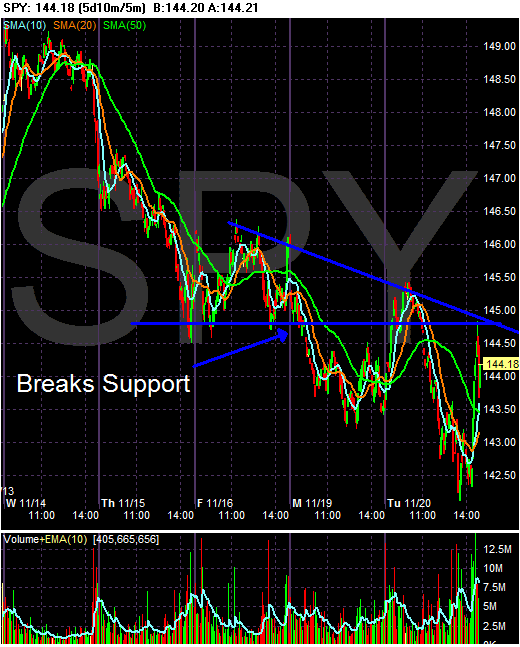
One hell of a day in the market today. The market opened higher then sold-off. However, the markets rallied hard with about a half hour left in trading. My guess is the market hit some technically important levels. The QQQQs started rallying at 49 and the SPYs at 142.50. Considering the heavy volume, this makes sense.
However, notice the SPYs still aren't above the horizontal support line from about a week ago. There is also the downward sloping resistance line from the last few days. Now, it's possible the markets open tomorrow with an upward spike to clear both of these resistance levels. But...
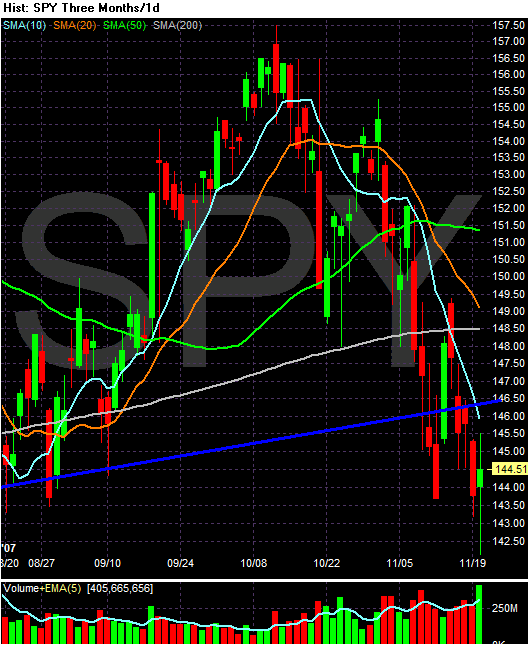
Notice on the daily chart we're still below the 200 day SMA with the shorter SMAs moving lower still. It is possible to look at today as a selling climax. Notice the heavy volume, which is usually a sign of a climax. Obviously, we'll have to wait and see tomorrow if that is right or not.
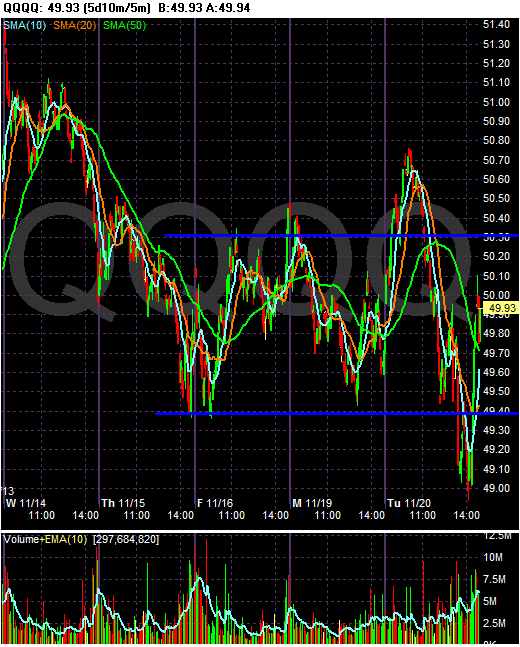
The 5-day QQQQ chart puts today's action in some much-needed perspective. The lower trendline is pretty obvious. I've eyeballed the top one which could be in a few other spots. But the bottom line is the QQQQs are stuck in a bit of an overall range right now, trying to figure out what to do.
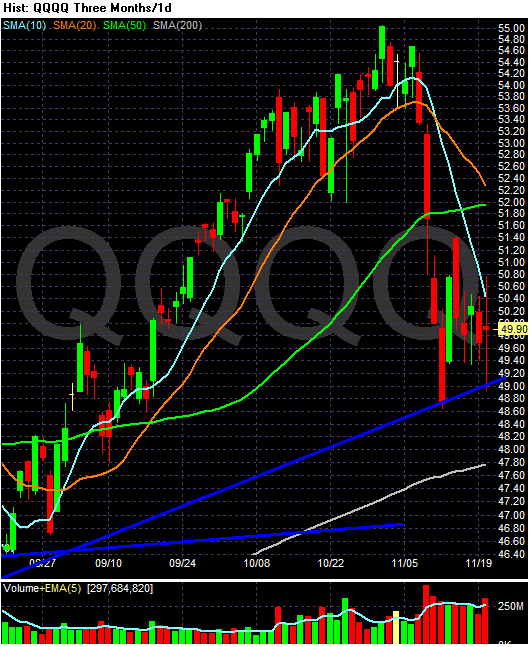
The daily charts makes the range a lot more obvious. The QQQQs could be forming a bottom hear. This would make sense considering the heavy selling action the index saw last week.
A Fool and His Money....
From Businessweek:
I've been making a great deal of fun of this philosophy, and frankly will continue to do so. This is stupid beyond belief. Anybody who us making this move is making a classic investment mistake. They are assuming that:
1.) Because something is cheap relative to a another price at a certain time it is time to buy something,
2.) There is only so far a large stock can fall, and
3.) There won't be anymore major damage to the financial section of the market.
Let's rebut these argument one at a time.
1.) Because something is cheap relative to a another price at a certain time it is time to buy something:
There are two kinds of cheap. The first kind is an undiscovered gem -- a company who's book value is higher than it's stock value. This is classic "value investing" (for more on this, read the Graham and Dodd book Securities Analysis.) This is not what we're talking about here.
What we are talking about with financial stocks are securities which are cheap because they are crap. There have been over $50 billion in writedowns over the last quarter. And we're just getting started. Take a look at this chart from the IMF:
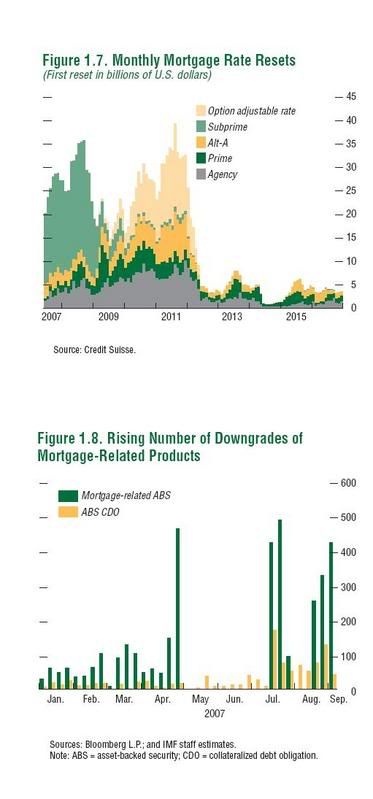
There are three more years of resets out there. Do you really think this is the only quarter when we're going to have writedowns?
The above chart is the reason these companies are cheap because they're crap.
2.) There is only so far a large stock can fall,
Right. A great company -- or a necessary company -- won't go below value x because it's so necessary too the economy. Take a look at (Fannie Mae) FNM or (Freddie Mac) FRE and ask yourself if that proposition still holds up.
3.) There won't be anymore major damage to the financial section of the market.
See the chart above. There is a ton of crap out there in financial-land. We don't know who owns how much of what -- and we won't know for some time. Companies are doing everything they can to not tell us, holding onto the pipe dream that somehow this whole mess will turn around.
So -- if anyone is telling you financial stocks are a great buy right now show them the door. The only good thing about financial stocks is they are great targets for shorting. That's it.
But are there investment opportunities amid the wreckage? Some investors think so. They're diving right in and gobbling up shares of the financial houses at the center of the maelstrom, including Bank of America (BAC), Citigroup, American International Group (AIG), JPMorgan Chase (JPM), Merrill Lynch, and Morgan Stanley (MS). "We are buying them all," says David Katz, chief investment officer at Matrix Asset Management, a New York money management firm with assets of $1.6 billion.
Are Katz and other money managers playing with fire? There certainly are risks. But the rewards to confronting the risks look compelling, given the financial firms' steep fall. As of Nov. 19, Citigroup is down to $32.50 a share from its 52-week high of $57 on Dec. 28, 2006. Bank of America is at $43.15, down from $55.08 on Nov. 20, 2006. AIG is at $55, down from $72.97 on May 11. JPMorgan is at $42, off from its high of $53.25 on May 9. Merrill Lynch tumbled to $53.50, from $98.68 on Jan. 18. And Morgan Stanley dropped to $51.16 from $75.50 on June 15.
The Case for Buying
The argument for buying is not that these companies won't have more problems. Perhaps some of them will. But Katz and others believe that, as a group, these giant finance companies play such a central role in the economy that they'll continue to have bright prospects. "We aren't playing with fire, because these companies are the biggest and the best players in finance and investments, with tremendous, diverse resources and clean balance sheets," says Katz.
I've been making a great deal of fun of this philosophy, and frankly will continue to do so. This is stupid beyond belief. Anybody who us making this move is making a classic investment mistake. They are assuming that:
1.) Because something is cheap relative to a another price at a certain time it is time to buy something,
2.) There is only so far a large stock can fall, and
3.) There won't be anymore major damage to the financial section of the market.
Let's rebut these argument one at a time.
1.) Because something is cheap relative to a another price at a certain time it is time to buy something:
There are two kinds of cheap. The first kind is an undiscovered gem -- a company who's book value is higher than it's stock value. This is classic "value investing" (for more on this, read the Graham and Dodd book Securities Analysis.) This is not what we're talking about here.
What we are talking about with financial stocks are securities which are cheap because they are crap. There have been over $50 billion in writedowns over the last quarter. And we're just getting started. Take a look at this chart from the IMF:

There are three more years of resets out there. Do you really think this is the only quarter when we're going to have writedowns?
The above chart is the reason these companies are cheap because they're crap.
2.) There is only so far a large stock can fall,
Right. A great company -- or a necessary company -- won't go below value x because it's so necessary too the economy. Take a look at (Fannie Mae) FNM or (Freddie Mac) FRE and ask yourself if that proposition still holds up.
3.) There won't be anymore major damage to the financial section of the market.
See the chart above. There is a ton of crap out there in financial-land. We don't know who owns how much of what -- and we won't know for some time. Companies are doing everything they can to not tell us, holding onto the pipe dream that somehow this whole mess will turn around.
So -- if anyone is telling you financial stocks are a great buy right now show them the door. The only good thing about financial stocks is they are great targets for shorting. That's it.
A BIG Concern Going Forward
From the Washington Post:
Each bank has a unique capital structure, so grand, over-arching predictions are difficult to make. But we've seen a ton of writedowns this quarter. If memory serves, we've seen $50 billion or so. That's more than chump-change; that's serious. And considering the the overall reset schedule out there, it's bound to get worse before it gets better.
At some point, these writedowns will start to impact lending ability. That was the gist of Goldman Sach's recent prediction.
I don't know where that line is or if we've already crossed it. But if we haven't crossed it, we're getting a whole lot closer than we would like to admit.
Economists increasingly worry that banks are suffering such massive losses that they will be forced to cut back their lending to consumers and businesses. That would slow the economy, much as the savings and loan crisis did in the early 1990s. Yesterday, an analyst predicted that Citigroup, the world's biggest financial services company, would suffer another $15 billion in losses in the coming six months from its exposure to exotic types of debt.
Each bank has a unique capital structure, so grand, over-arching predictions are difficult to make. But we've seen a ton of writedowns this quarter. If memory serves, we've seen $50 billion or so. That's more than chump-change; that's serious. And considering the the overall reset schedule out there, it's bound to get worse before it gets better.
At some point, these writedowns will start to impact lending ability. That was the gist of Goldman Sach's recent prediction.
The direct losses from mortgage foreclosures will be about $400 billion, economists at Goldman Sachs estimated in a report last week. If that were the extent of the losses, the financial system could easily absorb them. But because of the way banks and other institutions work, the losses could spread far more widely.
Banks are required to keep capital on hand so they can weather losses. The mortgage-related losses are cutting into their capital and thus could cause a commensurate drop in how much they can loan. Taking into account that "multiplier" effect, the mortgage problems could reduce by $2 trillion the credit available to consumers and businesses, Goldman estimated in the report.
I don't know where that line is or if we've already crossed it. But if we haven't crossed it, we're getting a whole lot closer than we would like to admit.
Retailers Facing Tougher Christmas Season
From Bloomberg:
Also from Bloomberg (from an Office Deport Story):
Now -- every year that I can remember there have been warnings about consumer spending slowing down. These reports don't count on the fact the US consumer loves to ship and will do anything to keep on shopping. It's that simple.
However, the article points to some serious issues: falling homes prices, high energy costs and high consumer debt levels. One of those would probably not be enough. But three -- together? That could be.
Clothing chain Limited Brands Inc., based in Columbus, Ohio, will probably show that it broke even in its third quarter, according to 19 analysts surveyed. That would be the company's worst earnings performance in two years.
Merchants including Kohl's Corp. said they're planning conservatively next year after third-quarter sales trailed predictions.
Lowe's, based in Mooresville, North Carolina, lowered its earnings forecast for the rest of the year ending Feb. 1 as it reported a 10 percent drop in third-quarter profit amid the worst U.S. housing recession since 1991.
Last week J.C. Penney Co., the third-largest U.S. department-store company, and Seattle-based Starbucks Inc., the world's largest coffee-shop chain, also reduced their profit outlooks, as did Atlanta's FedEx Corp., the second-largest U.S. package-shipping company.
``A weakening housing market continues to take a toll,'' Brian Nagel, an analyst with UBS Securities LLC, wrote in a note yesterday.
Cost of Heat
So are consumer debt levels, rising gasoline prices and higher home-heating costs, according to a survey released yesterday. The research, by the Consumer Federation of America and the Credit Union National Association, found that 35 percent of Americans polled said they intend to lower their holiday spending this year, the most in eight years and up from 32 percent last year.
Also from Bloomberg (from an Office Deport Story):
``The overall retail environment is tough, especially with consumers and small businesses who tend to mirror overall consumer behavior,'' Anthony Chukumba, an analyst at FTN Midwest Securities Corp. in New York, said yesterday. ``They've gone overboard with cost-cutting, and it affects the in-store experience.'' He recommends holding the shares.
Now -- every year that I can remember there have been warnings about consumer spending slowing down. These reports don't count on the fact the US consumer loves to ship and will do anything to keep on shopping. It's that simple.
However, the article points to some serious issues: falling homes prices, high energy costs and high consumer debt levels. One of those would probably not be enough. But three -- together? That could be.
Gulf States Retinking Dollar Peg
From the WSJ:
The weekly dollar chart says sell me:

This is a beat market chart. Prices are making lower lows and lower highs. Prices are also continually breaking previous support levels.
If this happens -- one of these countries breaks their dollar peg -- the chances are better than 50% it would start a run on the dollar (in my opinion). It would cause a short-term dislocation in the market. It would be very, very, bad.
For many years, oil-rich Persian Gulf states have pegged their currencies to the dollar. Now that link is stoking a bad bout of inflation in their red-hot economies and putting policy makers in a dilemma: Break the dollar peg and risk undermining the U.S. currency, or keep it and face growing local discontent.
The dollar peg has "served the economy...very well in the past," said Sultan Nasser al-Suweidi, the governor of the United Arab Emirates' central bank, last week. "However, we have reached a crossroads."
The weekly dollar chart says sell me:

This is a beat market chart. Prices are making lower lows and lower highs. Prices are also continually breaking previous support levels.
If this happens -- one of these countries breaks their dollar peg -- the chances are better than 50% it would start a run on the dollar (in my opinion). It would cause a short-term dislocation in the market. It would be very, very, bad.
A breakdown of the Five Largest S&P Sectors
The five largest industrial areas of the S&P 500 are the financials (19.82%), Information Technology (16.18%), Energy (11.68%), Health Care (11.64%), and Industrials (11.51%). Let's look at the charts from the largest to the smallest to see what they look like.
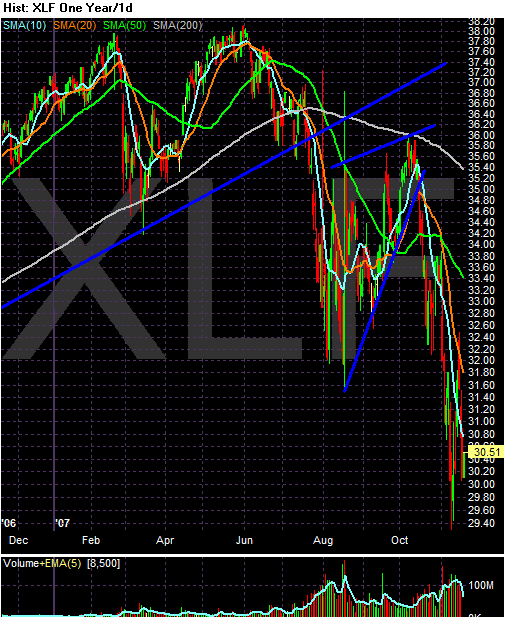
The financials look terrible. They're far below the 200 day simple moving average (SMA), the shorter SMAs are moving lower and prices are clearly looking for a bottom. This is a sector to avoid unless you are looking to short something.
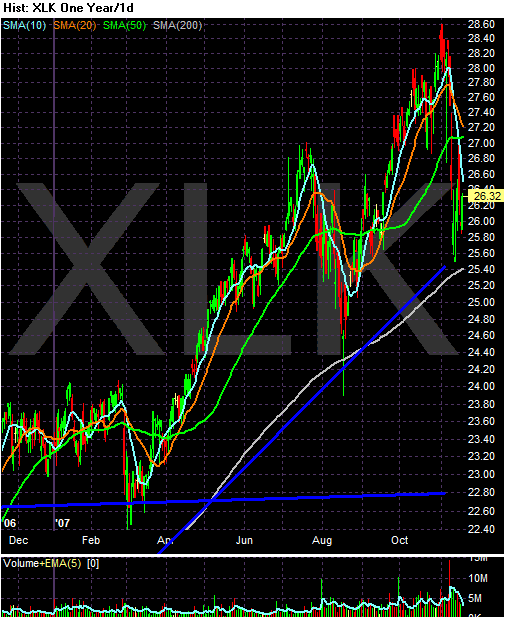
Information Tech is doing pretty well; it's still in an uptrend that it started in the fall of 2006. However, prices are currently below the SMAs and the shorter SMAs are moving lower. This is a sector to keep a close eye on to see how it moves over the next few weeks.
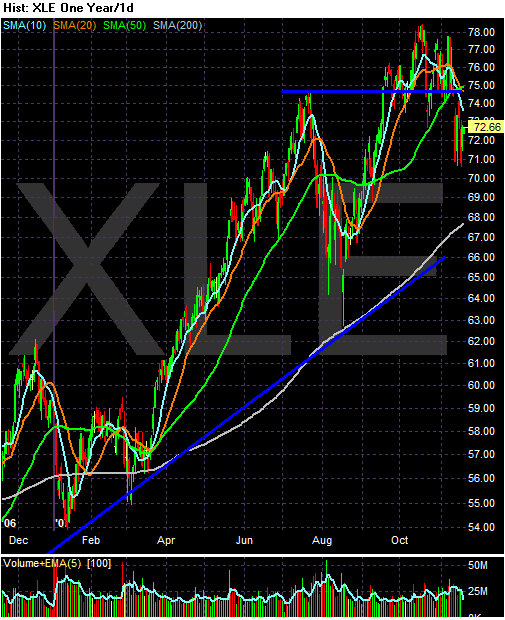
Energy is clearly in a rallying market. Notice it is making higher highs and higher lows and it has a clear uptrend in place.
However,
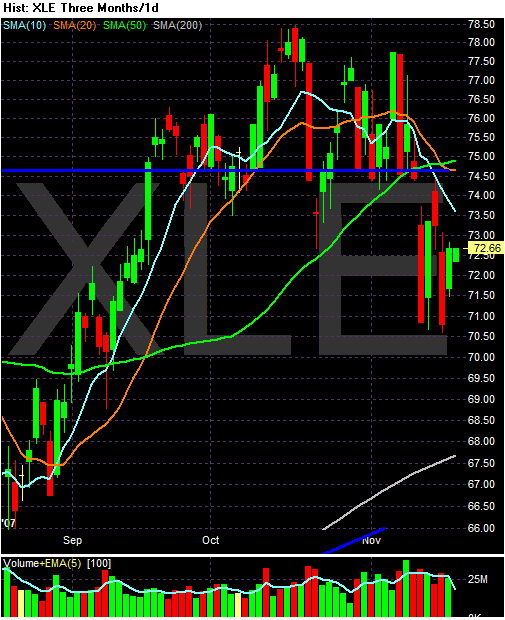
Notice the index gapped lower about a week ago. My guess is traders have started taking profits from energy's long rally as we approach the end of the year. This is something to keep an eye on as well.
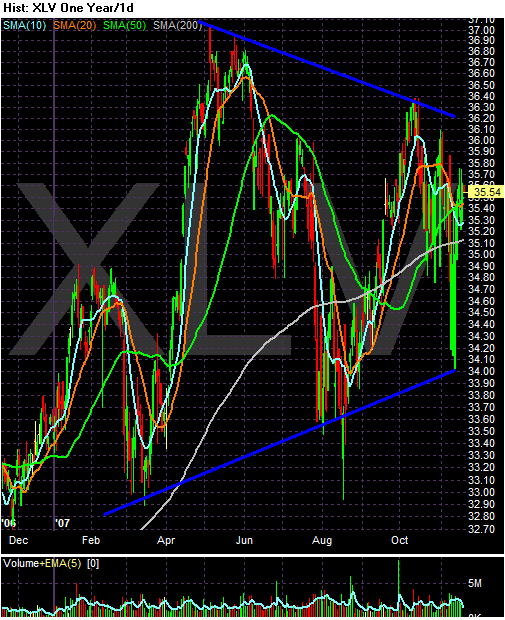
Health care is in the middle of a giant, year-long triangle consolidation.
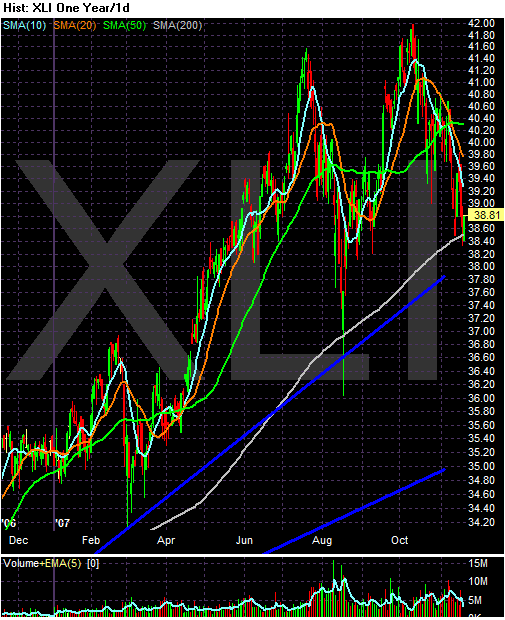
The industrial sector is also in the middle of a rally. But notice this index may have formed a double top and is trading right at the 200 day SMA.
So --
1.) One sector (financials) is broken. This is also the largest market sector so this is a problem.
2.) Energy, Industrials and Technology are in fair to good shape, but they need to be watched very closely.
3.) One sector -- health care -- is consolidating. This makes it a decent repository of safe money.
In other words, even the sectors that are in long-term rallies have to be watched closely right now.

The financials look terrible. They're far below the 200 day simple moving average (SMA), the shorter SMAs are moving lower and prices are clearly looking for a bottom. This is a sector to avoid unless you are looking to short something.

Information Tech is doing pretty well; it's still in an uptrend that it started in the fall of 2006. However, prices are currently below the SMAs and the shorter SMAs are moving lower. This is a sector to keep a close eye on to see how it moves over the next few weeks.

Energy is clearly in a rallying market. Notice it is making higher highs and higher lows and it has a clear uptrend in place.
However,

Notice the index gapped lower about a week ago. My guess is traders have started taking profits from energy's long rally as we approach the end of the year. This is something to keep an eye on as well.

Health care is in the middle of a giant, year-long triangle consolidation.

The industrial sector is also in the middle of a rally. But notice this index may have formed a double top and is trading right at the 200 day SMA.
So --
1.) One sector (financials) is broken. This is also the largest market sector so this is a problem.
2.) Energy, Industrials and Technology are in fair to good shape, but they need to be watched very closely.
3.) One sector -- health care -- is consolidating. This makes it a decent repository of safe money.
In other words, even the sectors that are in long-term rallies have to be watched closely right now.
Monday, November 19, 2007
GM at 52 Week Low

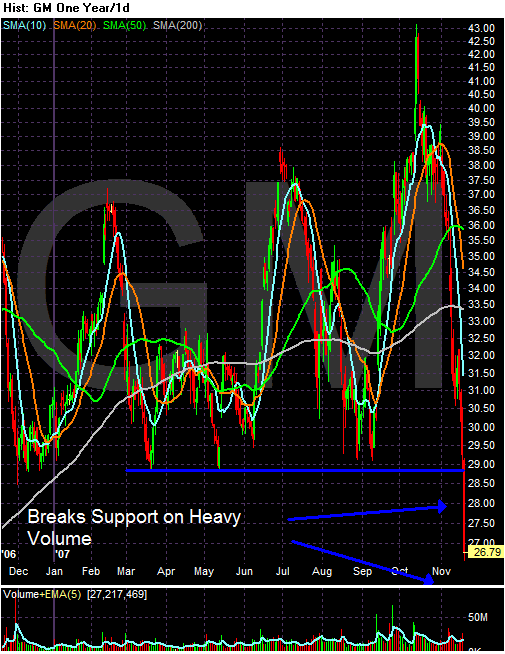
GM broke an important support level today on heavy volume. That's not good news going into tomorrow.
Today's Markets
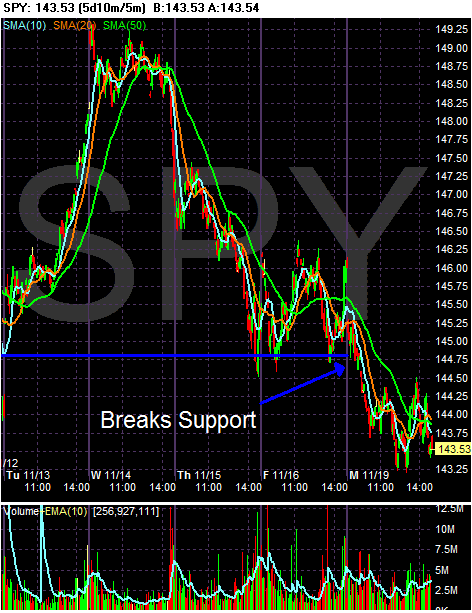
The main issue with the SPYs today is they broke technically important support. They dropped, then rallied and finally settled lower. This support line has been around for the last 5 days. The longer the support, the more important its break.
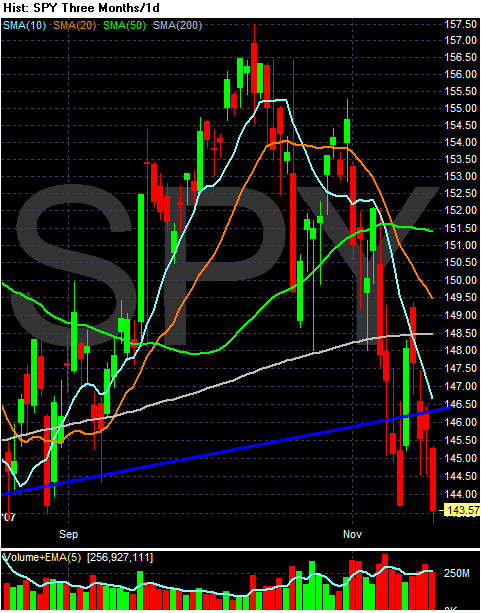
The SPYs daily chart looks terrible. Notice the long bar, heavy volume and the fact that price is below the 200 day SMA. The shorter term SMAs are also moving lower. This chart says sell me.
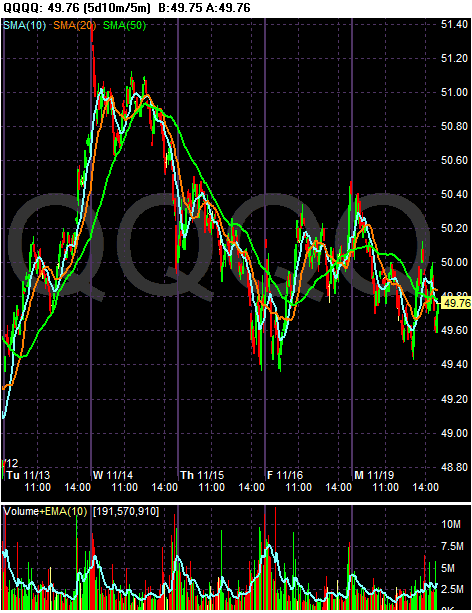
The QQQQs are in a range between 49.60 and 50.40. They're bouncing around between those two levels.

The the QQQQs are still above the 200 day SMA and an important long-term trend line. The index is consolidating at these levels, waiting for a reason to move in one direction or the other. But we don't know which one yet.
If This Happens, We're Hosed
From Marketbeat:
Here's a yearly chart that I used over the weekend.

This chart already says "sell me."
1.) The index is way below the 200 day SMA
2.) All the simple moving averages are moving lower.
3.) The shorter SMAs are below the longer SMAs
4.) Prices are below all the SMAs.
If OPEC dumps the dollar, we've in a terrible place.
Add Saudi Arabia to the growing list (one that already includes Jay-Z and Giselle Bundchen) of those wary of the dollar. OPEC ministers are clearly wary of the dollar’s decline — which continues today — and as oil producers struggle to deal with the weak greenback (since oil is denominated in dollars), analysts say now is a time to be concerned. “While many commentators, analysts and media have wondered at which point the dollar’s decline is considered at a dangerous level, it is precisely when the influential group of oil producers begin mulling plans to receive payments in currencies other than US dollars for their oil,” says Ashraf Laidi, chief forex analyst at CMC Markets.
Here's a yearly chart that I used over the weekend.

This chart already says "sell me."
1.) The index is way below the 200 day SMA
2.) All the simple moving averages are moving lower.
3.) The shorter SMAs are below the longer SMAs
4.) Prices are below all the SMAs.
If OPEC dumps the dollar, we've in a terrible place.
Citigroup Analyst Provides Comic Relief
From CNBC:
From the same article:
That's right -- $50 billion in losses means the sector is "oversold". Anyone who takes that advice deserves to lose money.
Tanona issued his report after Citigroup strategist Levkovich on Nov. 16 upgraded the banking sector, saying it has "compelling valuations and beaten down earnings estimate revisions, not to mention repulsive sentiment around these stocks, a contrarian signal."
From the same article:
Banks have announced more than $50 billion of write-downs tied to the U.S. housing slump, as defaults soared and the value of mortgages that investors deemed too risky plummeted.
That's right -- $50 billion in losses means the sector is "oversold". Anyone who takes that advice deserves to lose money.
Why Financials Are Still Very Dangerous
From Bloomberg:
Two weeks ago, everything was fine. The company reported no problems. Now -- two weeks later -- we have a mea culpa regarding a writedown. There is no way that Swiss Re didn't know about this two weeks ago; this is not the kind of loss that just "appears". They had to know about it and refused to disclose it.
Swiss Reinsurance Co., the world's biggest reinsurer, had a 1.2 billion-Swiss franc ($1.07 billion) loss on derivatives in October after the U.S. subprime mortgage crash roiled debt markets.
.....
``We clearly made some poor choices,'' Roger Ferguson, the former U.S. Federal Reserve governor who runs Swiss Re's financial services division, told analysts on a conference call. Swiss Re's loss came less than two weeks after the company reported third-quarter profit that surpassed analysts' estimates.
``This is a surprise, particularly given their so recent reporting,'' said Richard Hewitt, an analyst at Dresdner Kleinwort who rates Swiss Re ``buy.''
Two weeks ago, everything was fine. The company reported no problems. Now -- two weeks later -- we have a mea culpa regarding a writedown. There is no way that Swiss Re didn't know about this two weeks ago; this is not the kind of loss that just "appears". They had to know about it and refused to disclose it.
An Overview of Recent Manufacturing Reports
We're at a point in the month where there have been several manufacturing reports. In addition, the recent industrial production number seemed to cause some concern. So let's look at some of these recent reports.
From the Federal Reserve:
Still, as this chart from Econoday indicates, overall industrial production is still positive.
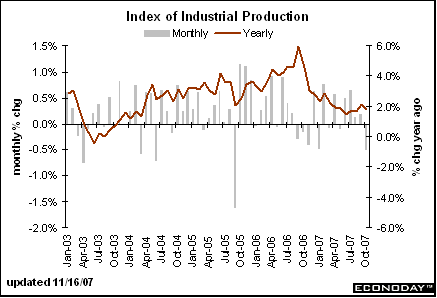
This chart looks like the best way to describe US manufacturing is "fair". It could be higher, but we're still positive and still growing. My guess is foreign demand is really helping out with this figure.
From the Philadelphia Fed (November 15):
This, again, looks like a "fair" report. There are two causes for concern. The first is the decrease in employment. This could indicate companies are looking to scale back costs. Secondly, the prices paid for inputs category is increasing. I am always suspicious of future predictions and tend to discount them regardless of the overall sentiment.
From the NY Fed (November 15):
Here's the accompanying chart:
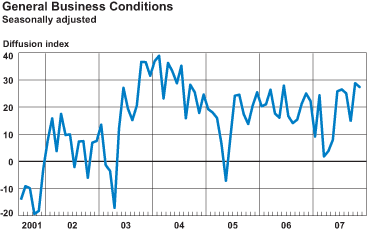
I would also classify this report as fair. The accompanying chart indicates overall conditions are fine; they're at levels seen in 2004, 2005 and 2006. Again we see a decline in the employment number. This is consistent with the Philly survey and could indicate a shift in business sentiment. However, one month is not a trend and we need more data before we draw a firm conclusion.
On October 31, the NAPM index dropped to 49 (PDF). New orders dropped as well. Here's the report's conclusion:
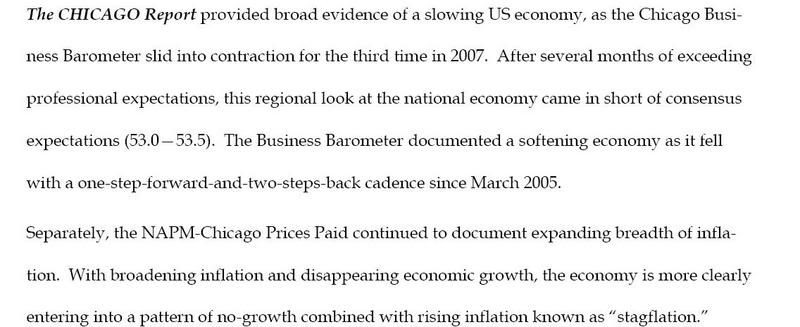
This conclusion is a cause for concern.
From the Kansas Fed (October 25):
Once again we see employment as "sluggish." That's the third district that has made a negative comment about employment.
Richmond Fed (October 23):
While this index dropped, it did so after four months of increases. This looks more like a natural pullback rather than a problem.
The overall read I get from all of these reports is "fair" with cause for concern. The national number could be higher but is still expanding. While the latest figures showed a drop, it is only one month of information and the year over year chart still shows an expansion.
The regional reports are mixed, and three indicated that employment was a concern. This could be an indication that companies are looking to cut back on labor, which is never a good sign.
From the Federal Reserve:
Industrial production decreased 0.5 percent in October after having increased 0.2 percent in September. At 114.0 percent of its 2002 average, total industrial production in October was 1.8 percent above its year-earlier level. Output in the manufacturing sector fell 0.4 percent in October. The output of utilities dropped 1.6 percent, primarily because of a decline in gas utilities; the output at mines fell 0.6 percent, reversing September's gain. Capacity utilization for total industry declined to 81.7 percent, a rate equal to its year-earlier level but 0.7 percentage point above its 1972-2006 average.
.....
The output of consumer goods dropped 0.7 percent in October; the decreases were widespread
.....
The index for business equipment edged down 0.1 percent in October.
.....
In October, the index for construction supplies moved down 0.4 percent, its fourth consecutive monthly decline; nevertheless, the index remained 0.1 percent above its year-earlier level.
.....
The production of materials fell 0.4 percent in October after having risen 0.3 percent in September
Still, as this chart from Econoday indicates, overall industrial production is still positive.

This chart looks like the best way to describe US manufacturing is "fair". It could be higher, but we're still positive and still growing. My guess is foreign demand is really helping out with this figure.
From the Philadelphia Fed (November 15):
Activity in the region’s manufacturing sector continued to expand in November at about the same modest pace as in October, according to firms responding to this month’s Business Outlook Survey. Indicators for general activity and new orders remained positive and increased slightly from their readings last month. The employment index, while remaining positive, fell notably this month. Firms continued to report a rise in prices for inputs, and prices for the firms’ own manufactured goods have increased in recent months. The region’s manufacturing executives were substantially less optimistic about future activity than they were in October, and responses to special questions indicated that some firms are cutting back on fourth-quarter production plans.
This, again, looks like a "fair" report. There are two causes for concern. The first is the decrease in employment. This could indicate companies are looking to scale back costs. Secondly, the prices paid for inputs category is increasing. I am always suspicious of future predictions and tend to discount them regardless of the overall sentiment.
From the NY Fed (November 15):
The Empire State Manufacturing Survey indicates that conditions for New York manufacturers improved in November, at a pace close to that observed in October. The general business conditions index held steady at 27.4. The new orders and shipments indexes were also elevated and near last month’s levels. The prices paid index rose to its highest level in more than a year, while the prices received index was less elevated and declined modestly. Employment indexes, though positive, were markedly lower than in October. The degree of optimism regarding conditions six months ahead deteriorated: future activity indexes remained positive but dropped noticeably. The future prices paid index rose sharply to its highest level in considerably more than a year.
Here's the accompanying chart:

I would also classify this report as fair. The accompanying chart indicates overall conditions are fine; they're at levels seen in 2004, 2005 and 2006. Again we see a decline in the employment number. This is consistent with the Philly survey and could indicate a shift in business sentiment. However, one month is not a trend and we need more data before we draw a firm conclusion.
On October 31, the NAPM index dropped to 49 (PDF). New orders dropped as well. Here's the report's conclusion:

This conclusion is a cause for concern.
From the Kansas Fed (October 25):
Tenth District manufacturing output expanded modestly in October, and producers remained largely positive about future activity. However, orders and employment indexes were sluggish, and firms continued to trim inventories. Most price indexes in the survey edged up slightly.
Once again we see employment as "sluggish." That's the third district that has made a negative comment about employment.
Richmond Fed (October 23):
Manufacturing activity pulled back in October; Shipments and new orders decrease; But expectations upbeat
Manufacturing activity in the central Atlantic region pulled back in October, after expanding during the previous four months, according to the Richmond Fed’s latest survey. The index of overall activity was pushed lower as shipments and new orders edged into negative territory. Most other indicators also suggested weaker activity. District contacts reported that the pace of hiring flattened, order backlogs declined further and delivery times grew more slowly. Furthermore, manufacturers reported that capacity utilization reversed its positive reading seen last month and that inventories grew at a slightly slower pace.
Despite the decline in activity, manufacturers were more optimistic about their future prospects in October. Firms anticipated that their shipments, new orders, capacity utilization and employment would grow more rapidly in the months ahead.
While this index dropped, it did so after four months of increases. This looks more like a natural pullback rather than a problem.
The overall read I get from all of these reports is "fair" with cause for concern. The national number could be higher but is still expanding. While the latest figures showed a drop, it is only one month of information and the year over year chart still shows an expansion.
The regional reports are mixed, and three indicated that employment was a concern. This could be an indication that companies are looking to cut back on labor, which is never a good sign.
Subscribe to:
Comments (Atom)